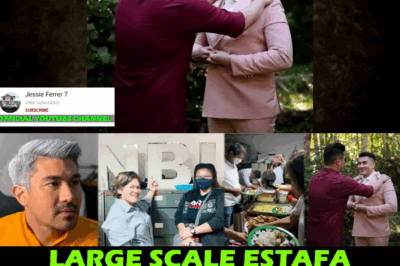From Friendship to Icons: The Untold Journey of Mother Ricky and Mama Renee
Some friendships are written in the stars. Others are forged in fire—through shared hardships, perseverance, and the refusal to let life’s cruelties define them. For Ricky Reyes, better known as Mother Ricky, and Renee Salud, affectionately called Mama Renee, their story is a tapestry woven from laughter, resilience, and the glitter of the Philippine fashion and beauty industries. Their bond began in the 1970s, when disco balls gleamed, bell-bottoms reigned, and society was still harshly unforgiving toward gay men.
What has kept them inseparable for more than five decades isn’t just their shared profession or their prominence as trailblazers in their fields—it’s the unshakable bond of being dreamers, breadwinners, visionaries, and most importantly, survivors.
The Beginning: A Dream in the 70s

When asked how long they had been friends, both didn’t hesitate: “Since the 70’s.” Those were the years when they were just beginning to carve their names in Manila.
Mother Ricky was barely fifteen when he became both a mother and a father to his younger siblings, sweeping salon floors just to earn tuition money. His dream was simple: to cut hair and to give his family a better life. But even as a sweeper in a Project 8 beauty parlor, he was already a star in the making—absorbing every snip, every stroke of a comb, every styling technique. Within three months, he was the parlor’s “star of the show.”
Mama Renee, on the other hand, was a fresh-faced teenager from the province who tried, unsuccessfully, to pursue architecture. “When your plate is ruined, your whole drawing is ruined,” she quipped, recalling how her family’s financial struggles pushed her to abandon academics. At just sixteen, she walked into a Cubao department store called Bela’s, hoping to land a job as a designer.
Instead, she was placed in the warehouse—organizing fabrics by color, texture, and weight. What seemed like a humiliation turned into her foundation. The textures and fabrications she handled daily became the very education that no classroom could provide.
Together, Ricky and Renee entered their fields not with privilege, but with grit, creativity, and courage.
Gay, Proud, and Unapologetic
Their stories also reveal the struggles of growing up gay in a conservative Philippines.
Mother Ricky admitted he knew he was gay at ten years old. “I already had a crush on my neighbor,” he laughed. But being openly gay in the 1960s and 70s was no small feat. His father disowned him—not only because he was gay, but also because he was the child of a common-law wife. The shame of illegitimacy and homosexuality compounded the stigma.
“I had no relationship with my father,” Ricky said. “But after 1986, Henry Sy became my father figure. He told me, ‘So, you don’t have a father? Call me dad. I am your father.’”
That paternal mentorship changed everything. With Sy’s support, Ricky opened his first salon in SM North Edsa. Later, another father figure appeared—President Fidel V. Ramos, who wanted to adopt him.
Renee’s story was harsher. She recounted being punished by her own brothers, who forced her to “be a man.” She was hung upside down, locked in a chicken coop, and subjected to fire as a misguided attempt to “cure” her. It was what people then called “tough love.” Looking back, she said, “They thought it was for my own good. But it was abuse masked as love.”
Yet neither Ricky nor Renee ever wavered in their identity. “Peanuts are different from watermelon seeds,” Ricky often says—a metaphor that gay men and women must learn to accept their differences and limitations in relationships, particularly with men who will eventually leave them for women. It was brutal honesty, but it reflected their lived truth.
The Rise: From Floors to Runways
Despite the discrimination, their careers soared.
For Ricky, his rebonding technique revolutionized the beauty industry. He wasn’t just a hairdresser—he became a teacher, a philanthropist, and a household name. His project, “Isang Gunting, Isang Suklay” (One Scissor, One Comb), offered free training to mothers and unemployed women in Rizal in 1984. Backed by then-First Lady Imelda Marcos, the project empowered countless women with livelihood skills.
Renee, meanwhile, became the designer of dreams. She dressed the stars, made young actresses feel like royalty, and staged shows that defined eras. She saw talent where others only saw new faces. “When I first saw Toni Gonzaga, I thought, ‘Who is this fresh, thin girl? I want to dress her up.’” For many celebrities, wearing a Salud gown became a rite of passage.
Their rise was meteoric, but never free of sacrifice. Both remained single for years, putting family before love. “We were both breadwinners,” they said. “Our priority was to earn for the family.”
Love for Mothers, Love for Family
If there was one shared value that bonded them more than anything, it was their devotion to their mothers. Both Ricky and Renee credited their success to their love for family.
“Maybe what pushed us to be bigger is both of us loved our mothers,” Ricky reflected. “We both took care of our mothers and siblings.”
It was that sense of responsibility—of love turned into livelihood—that made them unstoppable. They proved that one can be poor but still happy, as long as there is a dream.
Lessons on Life, Love, and Survival

Throughout their careers, Ricky and Renee carried hard-earned wisdom.
On relationships: Ricky reminded gay men not to give everything to a fleeting romance. “If you earn one thousand, don’t give all of it to a man just because he goes with you to the movies. Keep most for yourself and your parents.”
On resilience: Renee insisted that hardships often hide blessings. Being assigned to a warehouse instead of a design desk gave her the foundation to become the designer she is today.
On dreams: Both emphasized that dreams must be coupled with action. “You put that dream into action,” Ricky said, “and you can change your life.”
Legacy: Icons Who Changed Industries
Today, Ricky Reyes and Renee Salud are more than friends. They are institutions. Ricky’s salons and advocacy programs have touched thousands of lives, while Renee’s gowns have graced international stages and crowned beauty queens.
But more than their professional triumphs, it is their friendship that shines brightest. They were there for each other through obscurity, through the sting of rejection, through the dizzying heights of fame, and through the inevitable criticisms of being public figures.
Not all artists, as Ricky said, could do what they did: rise, stay, and continue to inspire.
Conclusion: A Friendship That Defines Generations

What began in the 1970s as two gay teenagers hustling to survive has become a half-century friendship that shaped Philippine beauty and fashion. They were pioneers who challenged stereotypes, survived abuse, and created empires with nothing but scissors, fabric, courage, and dreams.
Their story is one of resilience, loyalty, and the power of embracing one’s truth.
Because in the end, Ricky and Renee didn’t just change their own lives—they changed an entire industry. And they did it side by side, with laughter, sass, and a love for family that never wavered.
Full video:
News
NAGTATAGONG PASTOR APOLLO QUIBOLOY: BIKTIMA NG ‘WITCH HUNT’ O TUMATAKAS SA KATOTOHANAN? Ang Lalim ng Sigalot sa Politika at Pananampalataya
NAGTATAGONG PASTOR APOLLO QUIBOLOY: BIKTIMA NG ‘WITCH HUNT’ O TUMATAKAS SA KATOTOHANAN? Ang Lalim ng Sigalot sa Politika at Pananampalataya…
DUGO AT BUHOK NI CATHERINE CAMILON, KUMPIRMADO SA SASAKYAN NG MAJOR: Pulis-Suspek at Driver, TULUYANG NAGMAHIMIKAN; HUSTISYA, NAHIHINTO SA GITNA NG KONTROBERSYA
DUGO AT BUHOK NI CATHERINE CAMILON, KUMPIRMADO SA SASAKYAN NG MAJOR: Pulis-Suspek at Driver, TULUYANG NAGMAHIMIKAN; HUSTISYA, NAHIHINTO SA GITNA…
P150-M CONFIDENTIAL FUND NG DEPED, SASABOG NA BA? AFP OFFICERS, UMAMIN: WALANG PONDO MULA KAY VP DUTERTE ANG IPINAMBAYAD SA YOUTH SUMMITS!
Ang Malaking Butas sa P150-M Confidential Fund ng DepEd: Mga Opisyal ng AFP, Direktang Sumalungat sa Posisyon ng Kagawaran Ang…
KINILABUTAN! Lumalalim na Ugnayan ng POGO, Sindikato, at Pulitika, Kumpirmado: Mayor Alice Guo, Puno’t Dulo ng ‘National Security Threat’
KINILABUTAN! Lumalalim na Ugnayan ng POGO, Sindikato, at Pulitika, Kumpirmado: Mayor Alice Guo, Puno’t Dulo ng ‘National Security Threat’ Sa…
BILIBID SA ISANG GABI: CEDRIC LEE, BINANATAN SI VHONG NAVARRO MATAPOS SENTENSIYAHAN NG RECLUSION PERPETUA!
BILIBID SA ISANG GABI: CEDRIC LEE, BINANATAN SI VHONG NAVARRO MATAPOS SENTENSIYAHAN NG RECLUSION PERPETUA! Arestado, Nagkasakit, Ngunit Hindi Nagpatalo:…
Ang P66 Milyong Tanong: Paano Naabswelto si Luis Manzano sa Flex Fuel Estafa Case, Habang 12 Opisyal ng Korporasyon ay Hinarap ang ‘Syndicated Estafa’ na Walang Piyansa?
Ang P66 Milyong Tanong: Paano Naabswelto si Luis Manzano sa Flex Fuel Estafa Case, Habang 12 Opisyal ng Korporasyon ay…
End of content
No more pages to load












